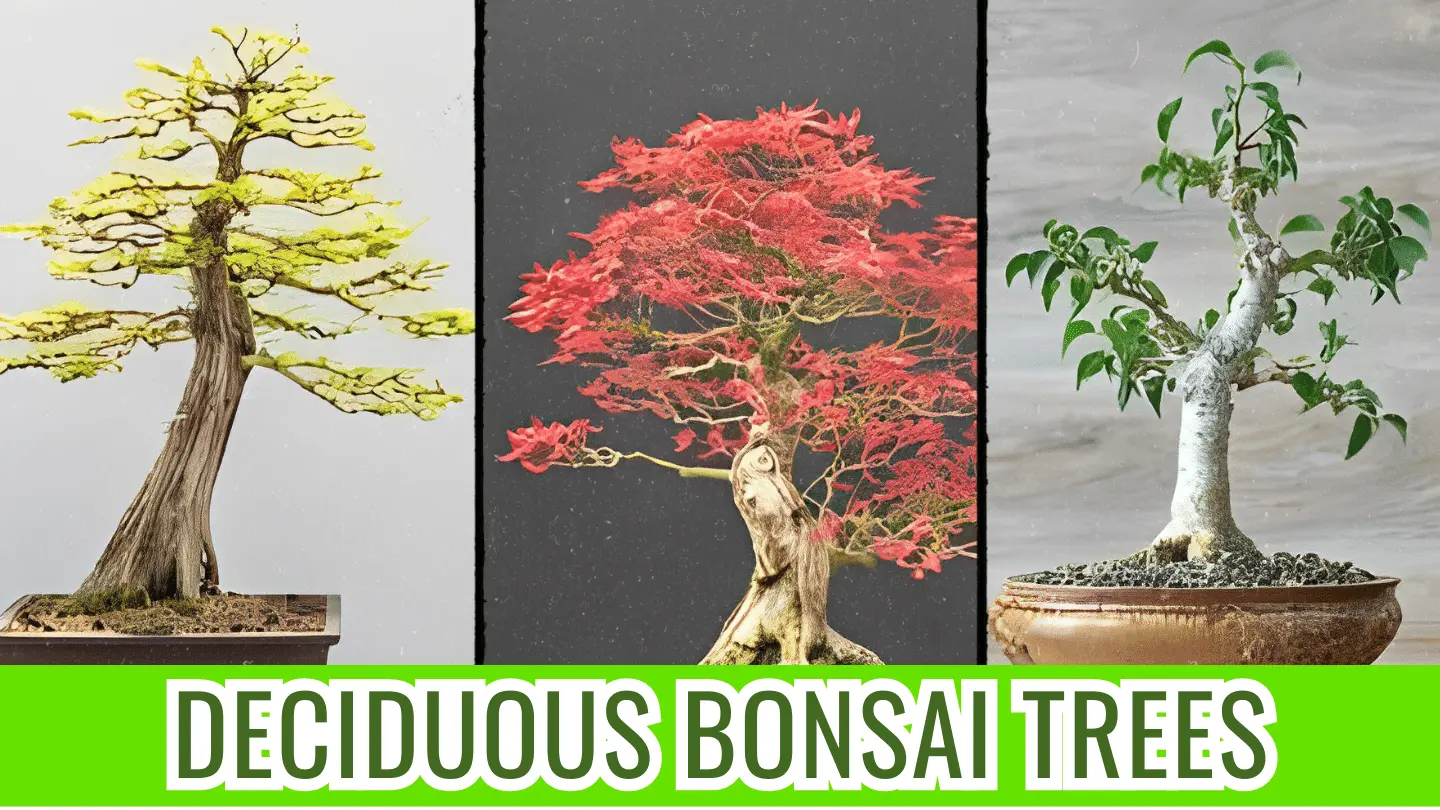Maybe your current desk plant does nothing for you. If you feel that way, how about trying a deciduous bonsai instead? Unlike predictable, uniform alternatives, these mini trees change with the seasons, displaying bright fall colors and bare winter branches. You might find this continual variation fascinating and intriguing.
Figuring out the proper watering schedule, especially in winter, can feel a bit tricky. And picking the perfect tree for your space might seem overwhelming at first. Don’t give up, though! With just a little bit of guidance, maintaining their happiness and health is a breeze.
Once you get the hang of it, these tiny trees transform your desk. You’ll have an awesome, eye-catching spot in no time.
Also read: Coniferous Bonsai Trees: The Ultimate Guide
What is So Special About Deciduous Bonsai Trees:
Deciduous bonsai aren’t just miniature trees – they’re living sculptures that paint their own masterpiece throughout the year. Unlike their evergreen cousins, these bonsai trees embrace change, putting on a breathtaking show with their seasonal transformations.
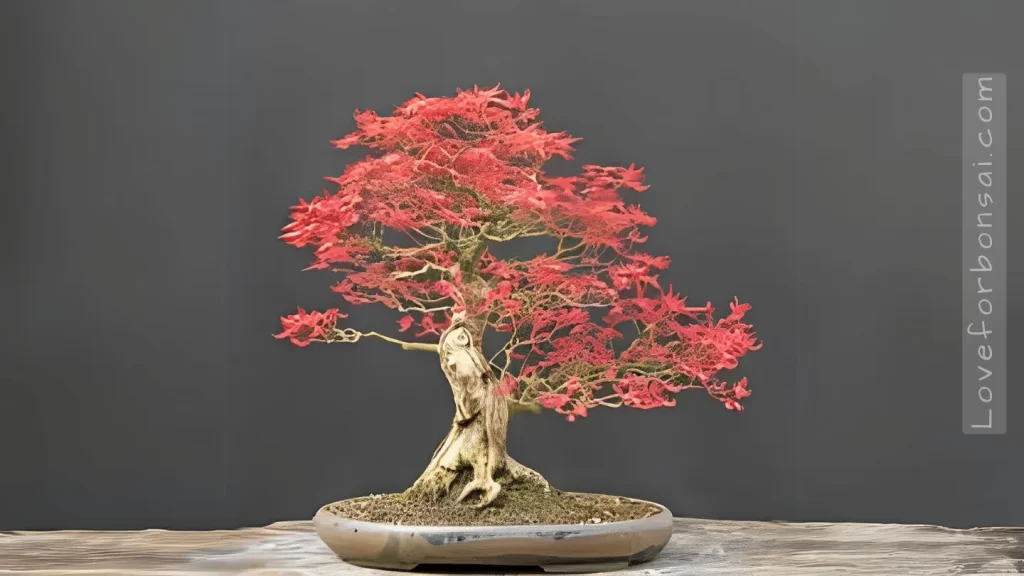
Leaf Magic:
- Springtime Explosion: Imagine your desk erupting in a riot of green! As the days lengthen, deciduous bonsai unfold their leaves, each species boasting its own unique flair. Delicate maples unfurl their intricate fans, while elms sprout leaves like miniature emeralds.
- Summer Symphony: Lush foliage takes center stage. Leaves reach their full glory, casting dappled shade and whispering secrets in the breeze. Some, like oaks, boast bold, textured surfaces, while others, like hornbeams, dance with delicate, fluttering leaves.
- Autumn’s Grand Finale: Get ready for a fireworks display! Deciduous bonsai paint the landscape with fiery reds, golden yellows, and deep purples. Each leaf becomes a tiny brushstroke, creating a mesmerizing tapestry before gracefully falling to the ground.
- Winter’s Stark Elegance: Don’t let the bare branches fool you! Stripped of their leaves, deciduous bonsai reveal their true character. Twigs reach out like delicate fingers, showcasing the intricate branching structure honed through years of careful shaping. The stark beauty of winter offers a glimpse into the intricate bones of the tree.
Growth Patterns:
Deciduous bonsai isn’t just about the leaves, though. Their growth patterns are as diverse as their foliage. Some, like Japanese maples, grow compact and bushy, perfect for a smaller desk. Others, like hornbeams, stretch taller and more upright, adding a touch of elegance to your space.
Understanding the natural growth habit of your chosen species will help you shape and style it into a miniature masterpiece.
Popular Deciduous Bonsai Trees
Many deciduous trees make excellent candidates for bonsai. When selecting a starter tree, opt for a hardy species that is native to your region.
Here is a table of the 10 most popular deciduous bonsai trees with their scientific names, attractive features, and best suitable bonsai style:
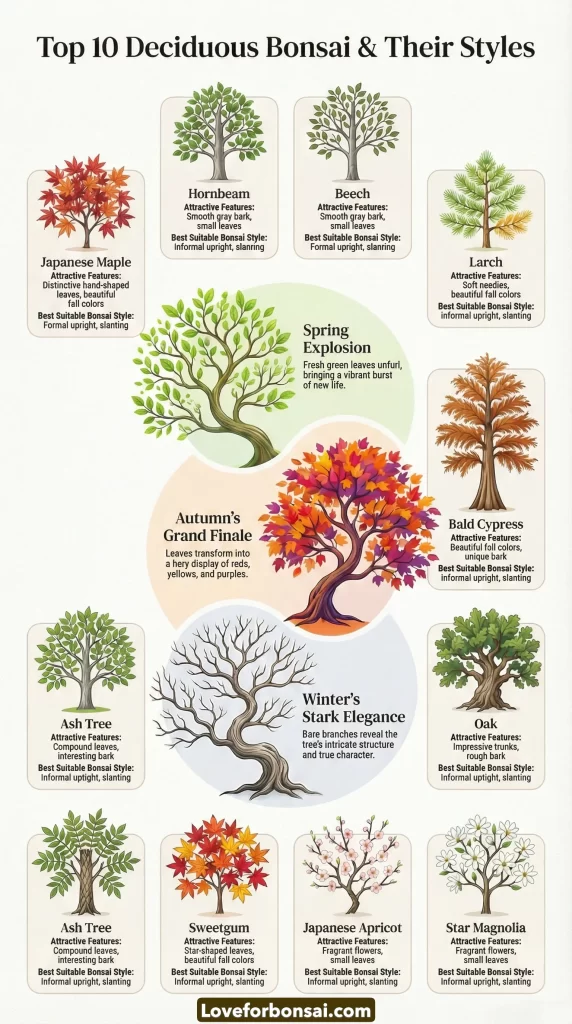
| Deciduous Bonsai Tree | Scientific Name | Attractive Features | Best Suitable Bonsai Style |
|---|---|---|---|
| Bald Cypress | Taxodium distichum | Beautiful fall colors, unique bark | Informal upright, slanting |
| Japanese Maple | Acer palmatum | Distinctive hand-shaped leaves, beautiful fall colors | Formal upright, slanting |
| Hornbeam | Carpinus betulus | Smooth gray bark, small leaves | Informal upright, slanting |
| Beech | Fagus grandifolia | Smooth gray bark, small leaves | Formal upright, slanting |
| Larch | Larix decidua | Soft needles, beautiful fall colors | Informal upright, slanting |
| Oak | Quercus spp. | Impressive trunks, rough bark | Informal upright, slanting |
| Ash Tree | Fraxinus spp. | Compound leaves, interesting bark | Informal upright, slanting |
| Sweetgum | Liquidambar styraciflua | Star-shaped leaves, beautiful fall colors | Informal upright, slanting |
| Japanese Apricot | Prunus mume | Fragrant flowers, small leaves | Informal upright, slanting |
| Star Magnolia | Magnolia stellata | Fragrant flowers, small leaves | Informal upright, slanting |
How to Select the Right Deciduous Bonsai Species for Your Garden
When selecting the right deciduous bonsai species, there are several important factors to consider for optimal growth.
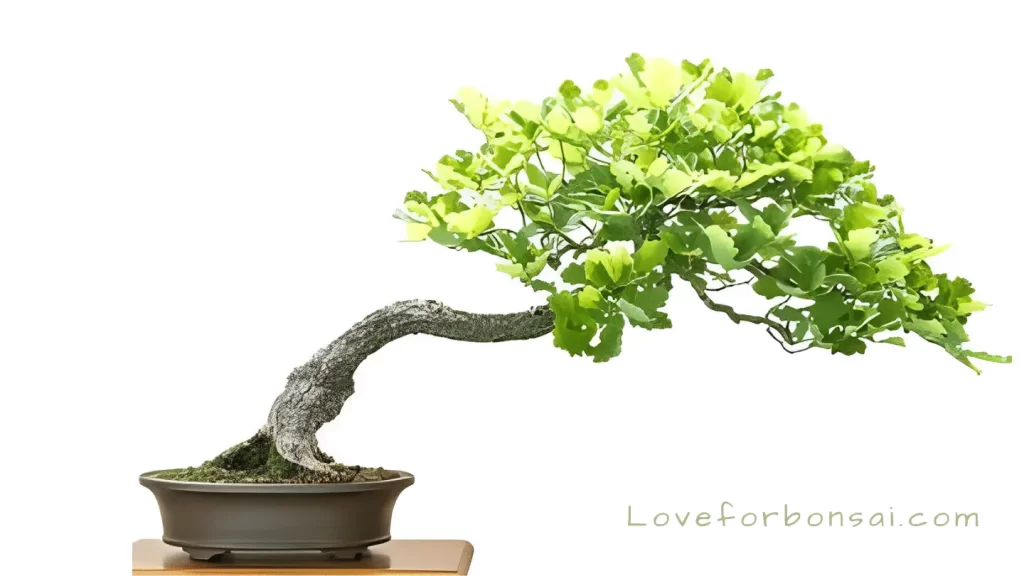
One of the key factors is the climate in which you live. Different species of deciduous bonsai have specific climate requirements, such as a certain number of chill hours or a specific temperature range. It is critical to choose a species that can thrive in your particular climate to ensure the best chance of success.
Another factor to consider is the level of care and maintenance required by the species. Some deciduous bonsai species are more sensitive and demanding, requiring frequent trimming, shaping, and precise watering.
These species may be more suitable for experienced bonsai enthusiasts who have the time and expertise to dedicate to their care.
On the other hand, there are species that are more hardy and forgiving, making them a better choice for beginners or those with limited time for maintenance.
Avoid collecting wild trees, as they often lack the specific characteristics desirable in bonsai. Opt for nursery-grown starter material or trained pre-bonsai instead.
Basic Care Guide:
Sunlight:
Deciduous bonsai love bright, indirect light. Imagine basking on a sunny porch – that’s the sweet spot. Too much harsh sun can scorch their leaves, and too little can make them stretch weakly.
Find the perfect balance, and your bonsai will soak up the sunbeams like tiny solar panels.
Temperature Control:
Most deciduous bonsai prefer cool to moderate temperatures around 60-70°F (16-21°C). In summer, provide good air circulation to prevent overheating. Winter dormancy calls for a cooler spot, but avoid freezing temperatures.
Think of a sheltered balcony or a bright, unheated room.
Watering:
Think of water as a lifeblood. Give your bonsai enough to keep the soil slightly moist, but never soggy. Touch the soil – is it damp? Cool, hold off. Dry? Time for a drink!
Adjust your watering depending on the season and pot size. Summer sun dries things out faster, while winter slumber requires less. Remember, overwatering is a bigger enemy than underwatering!
Fertilizing:
During spring and summer, when your bonsai is growing like crazy, give it a gentle feast with diluted fertilizer every 2-4 weeks. In autumn and winter, let it rest and skip the feeding.
Remember, too much fertilizer can burn the roots, so go easy!
Bonus Tip: Every bonsai tells a story, so pay attention! Wilting leaves might mean thirst, yellowing leaves could be too much water, and stunted growth might mean a lack of light. Adjust your care accordingly, and you’ll soon learn your bonsai’s unique language.
Seasonal Care for Deciduous Bonsai:

Deciduous bonsai trees require careful attention and nurturing throughout the year to maintain their health and vigor. Each season brings unique challenges and opportunities for growth, and understanding the specific needs of your tree during each phase is crucial to its long-term success.
In the spring, as the temperatures begin to rise and new buds emerge, it is essential to provide your bonsai with adequate sunlight and moisture.
Fertilizing during this time should be done sparingly, as the tree is focused on developing new foliage. Regular pruning and pinching of new shoots will help shape the tree and maintain its desired form.
As the summer arrives, attention should be given to water management, ensuring that the tree is adequately hydrated to withstand the heat.
Additionally, protecting the bonsai from excessive sunlight and providing shade during the hottest parts of the day is important to prevent leaf scorching.
Autumn arrives, a fiery painter transforming your tiny forest. Leaves become canvases splashed with crimson, gold, and amber. Soak up the show, for winter approaches. Before the first frost nips, give your bonsai a winter home.
A sheltered porch or cool room works wonders. Less water is needed now, as they enter a deep sleep. Don’t be surprised if leaves fall – it’s nature’s way of conserving energy.
Winter wraps the world in a hushed blanket. Your bonsai dreams beneath the frosty sky. Check occasionally, ensuring the soil doesn’t dry out completely. A gentle prune during winter’s slumber helps prepare for the spring awakening.
With every season, your deciduous bonsai tells a story. Embrace the changes, and adjust your care accordingly.
Bonus Tip: Keep an eye out for pests and diseases throughout the year. Early intervention can prevent major problems and keep your bonsai thriving.
Pruning and Shaping Deciduous Bonsai:
Pruning and shaping are crucial techniques for enhancing the aesthetic appeal of deciduous bonsai. By strategically removing unwanted branches and foliage, and guiding the growth of the tree, bonsai enthusiasts can create visually appealing shapes and forms that mimic the grace and beauty of mature trees in nature.
One essential technique for pruning deciduous bonsai is known as branch selection. This involves carefully studying the tree’s structure and identifying which branches contribute to the desired shape and overall harmony of the bonsai.
By removing unnecessary or competing branches, you can enhance the overall structure of the tree. It will also allow better light penetration and air circulation. Additionally, branch selection helps maintain the balance and proportion of the bonsai, ensuring its natural beauty is emphasized.
Another vital technique is known as branch bending. It allows you to shape and position branches and get your desired aesthetic effect.
Gently bend the living branches and secure them in place with wires. This way you train your bonsai to take on a more graceful and natural appearance.
Be very careful when bending branches, don’t put too much force, or it will harm the tree. With careful practice, the results of branch bending you can truly transform, and elevate the beauty of the bonsai.
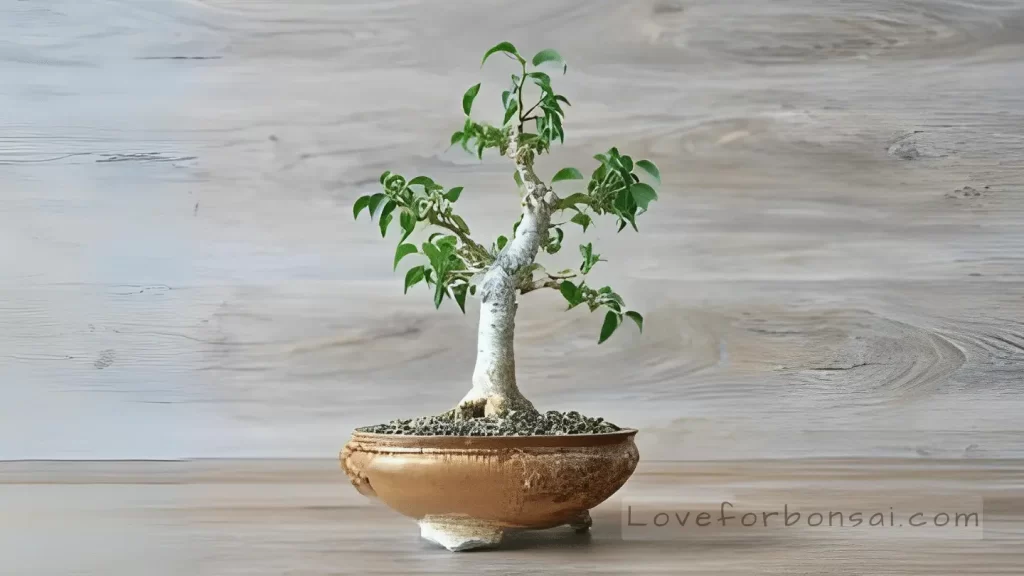
Wiring Deciduous Bonsai:
Deciduous bonsai trees possess a unique beauty that is enhanced by the art of wiring. This technique involves carefully wrapping and shaping the branches to create exquisite branch structures that contribute to the overall aesthetic appeal of the bonsai.
By manipulating the direction and position of the branches, the artist can create a sense of movement, balance, and harmony in the composition of the bonsai.
Wiring deciduous bonsai requires a delicate touch and a thorough understanding of the tree’s growth patterns. It is essential to choose the right wire gauge that provides enough support without causing any damage to the branches.
Additionally, the wiring process should be carried out during the tree’s active growing season when the branches are more flexible and responsive to manipulation.
Careful consideration must be given to the angle and direction in which the branches are wired, ensuring that they flow naturally and complement the overall design of the bonsai. With patience and skill, the art of wiring can transform a simple deciduous bonsai into a stunning work of living art.
10 Mind-Blowing Chinese Elm Bonsai Styles That Will Leave You Speechless
Repotting Deciduous Bonsai:
Repotting deciduous bonsai trees is an essential part of their care routine, ensuring their continued health and development. However, timing is crucial when it comes to repotting these delicate plants.
The best time to repot deciduous bonsai is during their dormant phase, which is typically in early spring or late winter. This allows the bonsai to recover and establish itself before the growing season begins.
The dormant phase is also the ideal time to remove any excess roots and prune the tree to maintain its desired shape.
When repotting a deciduous bonsai, it is important to follow the proper techniques to minimize stress on the tree.
Start by carefully removing the tree from its current pot, and gently loosening the root ball to ensure that you don’t damage any of the delicate roots.
Next, trim back about a third of the root mass, removing any dead or diseased roots as well. This will help to stimulate new root growth and improve the overall health of the bonsai.
After trimming the roots, place the tree in a new pot with a fresh, well-draining soil mixture, ensuring that the tree is positioned properly and stable in its new home.
Finally, water the bonsai thoroughly to settle the soil and provide adequate hydration.
Common Pests and Diseases:
Deciduous bonsai trees, like any other plants, are susceptible to various pests and diseases that can inhibit their growth and overall health. It is crucial for bonsai enthusiasts to be aware of these potential threats and take proactive measures to prevent and treat them effectively.
This table provides a concise overview of common problems faced by deciduous bonsai owners, along with practical solutions and preventative measures.
| Problem | Symptoms | Solutions | Prevention |
|---|---|---|---|
| Pests: Aphids, mealybugs, scale insects | Sticky sap, curled leaves, discolored patches | Neem oil spray, insecticidal soap, ladybugs (natural predators) | Regular inspection, neem oil spray as a preventative measure, avoid overcrowding |
| Diseases: Fungal infections, leaf spots | Brown spots, wilting leaves, stunted growth | Fungicide spray, improve air circulation, remove infected leaves | Avoid overwatering, proper drainage, avoid overhead watering |
| Leaf Drop: Excessive leaf drop, premature fall color | Sudden leaf loss, discoloration, stress | Reduce watering in fall, avoid fertilizer in winter, protect from harsh winds | Gradual acclimatization to seasonal changes, proper watering, avoid repotting during autumn |
| Weak Growth: Stunted branches, pale leaves | Thin branches, slow leaf development, lack of vigor | Increase light exposure, adjust watering, fertilize during growing season | Choose a suitable species for your climate, avoid overwatering, repot in well-draining soil |
| Yellowing Leaves: Nutrient deficiency, iron chlorosis | Leaves turning yellow between veins, lack of green color | Iron supplement for chlorosis, balanced fertilizer, adjust watering | Use iron-rich soil, avoid overwatering, proper drainage |
Please Remember:
- Early detection and intervention are key to minimizing damage.
- Always identify the specific pest or disease before applying treatments.
- Use natural methods whenever possible to avoid harming your bonsai or the environment.
- Regular inspection and preventive measures can save you time and frustration in the long run.
Final Thoughts:
Your bonsai isn’t just a pretty plant. It’s a living companion, a mindfulness guide, and a reminder that beauty blooms in unexpected places. Water your wonder, feed your curiosity, and let your bonsai lead you on an adventure through the ever-changing seasons.
And while you’re here, explore our website! From styling tips to bonsai whispers (we’ll translate!), there’s always something new to discover. Let your bonsai journey bloom, filled with colorful leaves, graceful branches, and endless possibilities.
